 |
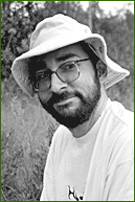 |
Luciano
de Bem Bianchetti and João A. N. Batista have been consecrating
their time to draw up a survey of the Orchidaceae family of Brazilian
Central Plateau emphasizing the difficult genus Habenaria and Cyrtopodium.
In this interview, we have the opportunity of knowing a little about this work and the difficulties they find, while we wait for their book with the results of the researches. Working at Embrapa and spending their spare and rest time for this study, they have been accumulating a considerable knowledge about this so specific habitat including the discovery of new species, some of them having their picture published for the first time, in this interview. |
|
ON:
Since
long time ago, you are taken with the
study of this almost unknown group,
Spiranthinae, although it is really representative of our orchidaceae
flora.
But, before getting into this subject, we would like to know a little about you, your occupation, how did you start to be interested in orchids and how did you start this work. LUCIANO: I am a biologist graduated from University of Brasilia (UNB), with specialization in Botany and Ecology. I became master of Botany, also from UNB. I have been working since 22 years in Embrapa – Genetical Resources and Biotechnology, in Brasília. The interest in orchids started when I was still doing my graduation. As many others, I enjoyed the shapes and the colors however I've never seen orchids in their natural environment. I imagined a kind of special environment, I meant, I believed that they just could survive in special environment such Atlantic Forest, rich in moisture and extremely protected by the luxurious vegetation. One day, talking about this subject with the architect Paulo Martins, he told me that he had collected some orchids in his house's neighborhood, in Brasília and invited me to see them in the field. I was surprised when I found the first terrestrial orchid growing in the Cerrado (woodland savannah) and exposed to full sun. This event aroused an increasing curiosity about the subject and allied to the fact that many species are found in our region (since I was doing classes in Botany and Ecology), I took up guiding my studies to this group of plants. At beginning, I missed to know the scientific name of the plants, because there are not experts in the University. On the other side, there was a good library with many books on this subject, between them, Flora Brasiliensis which presents many illustrations. So, comparing the plants I collected with those illustrations, I set to identify the plants and to take the way to vegetal taxonomy. I also missed people who would like the subject to change ideas. In the long run, I've got to know those people, Cilulia M. Maury, Ana Julia Heringer Salles and Fernando Thomé and we even formed a group. Each one of the group contributed with specific information related to our activities, occupation or experiences, such as, for example: Geography, cultivation, ecology, taxonomy, between others; one of the weak points of the group was the lack of photographic documentation of the species. By this time, we didn't know João. By chance, João, who has been working independently and did the documentation of the orchids, heard about the group and brought the some pictures to us for having a look. We just need it, not only because of the quality of the photos but also by the quantity of species he had already registered. As time went by and due to the personal interest (although all are still connected with orchids), the group has been dispersed. João and I still go on with taxonomy theme keeping this partnership until today. JOÃO: I has always been more interested in plants than the animals and while the most part of my friends in my childhood had a pet, I took care of the plants of the house. It is hard to say exactly when started my specific interest in orchids however I think that in large part it was due to the information I found in the books about orchids, where the contrast of the extremes, the diversity of the shape, colors, ecological adaptations and reproductive strategies, let me fascinated and aroused the curiosity for this group of plants. When I started the graduation in Biology, in Brasilia, and the visits in fields were very frequent, I took up an increasing contact with the native species of Brasilia, taking notes and photographing all species I came across. In 1989, I read in one of those weekly magazines an interview with Luciano and Ana Julia Heringer, where they described the work with the local orchids. I met both and because of our interest in taxonomy, I set with Luciano a work and a friendship which last until today. In spite of the personal interest for orchids, I opted for another career and after becoming master in Molecular Biology and had the doctor's degree, I work, at present, with molecular biology in plants at Embrapa - Genetical Resources and Biotechnology. In brief, I should point out that in spite of our common interest in the subject, nor me neither Luciano work professionally with orchids taxonomy. All work with orchids is done in our spare time and all cost are on our own. Though this situation exempts us from a bigger responsibility and from publishing in the area (We have just started to publish the knowledge accumulated all those years), the lack of financial resources and, mainly, the time, has been being the big obstacle to accomplish a series of studies and projects. |
| ON: Which is your great aim with this study? |
|
LUCIANO: There is a reasonable amount of information about orchids from Atlantic and Amazon Forest, mainly Atlantic Forest which is the Brazilian region with the biggest diversity and richness. On the other side, there is little information about orchids from the biome Cerrado. It covers at about 23% of the national territory, shelters from 500 to 600 species of orchids and has been suffering a violent antropization. According to official data, more than 50% of the natural vegetation has been already modified. Our main aim is to make people conscious by divulging information about the family, in such way that the information can give subsidy to take decisions turn to the conservational activities, mainly by the competent entities. Nobody conserve what he doesn't know. We are giving our contribution for the knowledge of this family in the Cerrado, registering, documenting, describing, bringing knowledge about those species and we expect, in a near future, to present this work in a book. |
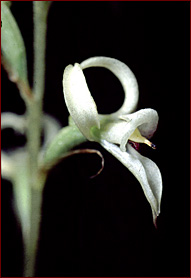 Notostheles |
|
ON:
In other words, what is exactly your study?
LUCIANO: As we have already said, our work consists in register, document, described and bring knowledge about the orchids occurring the biome Cerrado. Basically, our work is concentrated in Taxonomy area. |
|
ON:
Which is the studied area? Is it only Brasilia - Federal District (Distrito
Federal - DF)?
LUCIANO: We started with 'Distrito Federal' because of practical reasons such as proximity, facility to get in, etc. In course of time, we spread for another neighbor areas such as Chapada dos Veadeiros and Pirenópolis, for example. |
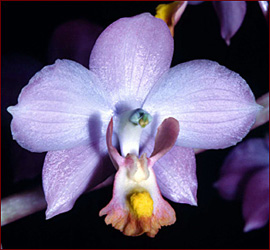 Cyrtopodium hatschbachii |
Nowadays, we work in almost every area where there is cerrado vegetation
(woodland savannah). However, DF has a series of particularities,
between them: a) it is placed in the central area of the biome Cerrado,
b) it has a considerable diversity of different environments, as all phyto-fisionomic
vegetation are found in the biome Cerrado are also found here and c) at
about 50% of the species already documented for the biome Cerrado are
represented in the DF. Concluding, if you have a good idea about the representation
of the orchids in DF, you have a good idea of the orchids from the biome
Cerrado.
JOÃO: For the groups we give more attention, Habenaria and Cyrtopodium, the study has no more just a local focus and we started to collect, even with our limitation of time and resources, in another regions of the country. |
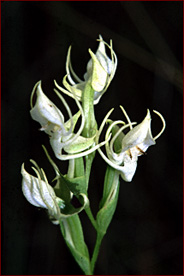 Habenaria lavrensis |
In this way, we have already made some travels to collect in south, southeast
and northeast regions.
ON: How long have you been doing this work? LUCIANO: At about 25 years. JOÃO: My approach in a more systematic way started in 1989, it means, at about 15 years. ON: In 1993, in an article published in Orquidário magazine, vol. 7(2), you said that there were 8 genera and at about 30 species occurring in DF, today, a decade after, how is this situation? LUCIANO: This work was just about the species of the Spiranthinae subtribe. DF has been, since the decade of 50, very well collected because there |
|
were botanists interested in orchids, such as Professor Ezechias Paulo
Heringer between others. The first surveys or even information about the
orchids from DF, used by Pabst & Dungs in the book Orchidaceae Brasilienses,
were extracted from the collections they done. For that reason, since
l993, the number of Spiranthinae species in DF didn't increase
much, because, practically, all of them were already registered, in one
way or another. Meantime, just one new genus (Eltroplectris) has
been registered for DF. However, in this period, many authors proposed
new taxonomical adjustments such as the separation of some genera.
JOÃO: Besides Eltroplectris, the division of Stenorrhynchus resulted in two genera for DF, Sacoila and Skeptrostachys, and from the subdivision of Cyclopogon, resulted Stigmatosema and Cyclopogon, that put together with some new registers of species make the total, nowadays, of 11 genera and 36 taxa (34 species, a variety and a form) of Spiranthinae for DF. It means, it increases a little and as many places in DF are not sufficiently studied it is still possible that there will be discovery to be done. |
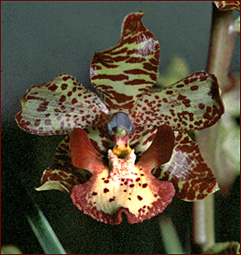 Cyrtopodium poecilum |
ON:
Which is the genus better represented in the studies area?
LUCIANO: The genus Cyrtopodium (at about 30 species) and Habenaria (at about 140 species) are very well represented in Cerrado so we concentrated our studies in them. We should do a remark about the works on Habenaria. |
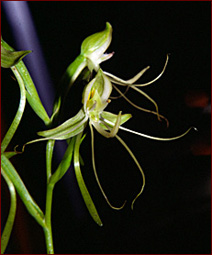 Habenaria pabstii |
|
This is a genus with many species, all of them are very similar and most
of them, little showy. May be because they present those characteristics,
the taxonomy of the genera is confused and there are few taxonomists interested
in them. In this context, João's work is, no doubt about, exceptional,
because he has been working with this difficult group since long time
ago and bringing considerable knowledge about the taxonomy of the genus.
Species of the subtribe Spiranthinae are also well represented.
|
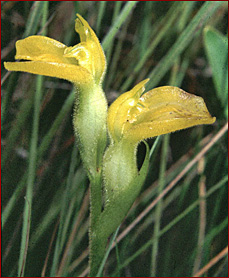 Sarcoglottis uliginosa |
JOÃO:
Concerning the Spiranthinae group, the genus with the greatest
number of species in DF and possibly in all Cerrado is Sarcoglottis
with 10 species and two taxa which are still studied.
Concerning the family as a whole, the genus with more species in DF is Habenaria, followed by Cyrtopodium. Many other genera, such as Cyanaeorchis, Galeandra, Liparis and Cranichis have a smaller number of species but include a great part of species which occur in Brazil and are, for this reason locally important. |
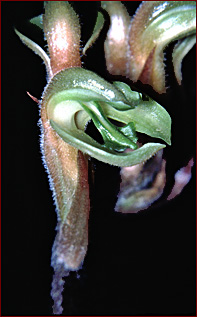 Sarcoglottis curvisepala |
|
ON:
In number of plants, which the species better represented?
LUCIANO: I believe that under certain favorable conditions, we have already came across to population of Habenaria with hundreds specimens. JOÃO: Probably, the easiest species to be observed in DF is Epistephium sclerophyllum, which has the most showy flowers and is quite common in dry lands and woodland savannah, the most common kinds of vegetation in DF. Concerning the Spiranthinae species, the most common species is probably Sacoila lanceolata (Stenorrhynchus lanceolatus), which occurs in many kind of habitats and, sometimes, in a great number. ON: The Central Plateau is not homogenous, in what kind of habitat this group occurs, mainly? |
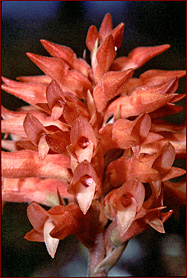 Sacoila lanceolata |
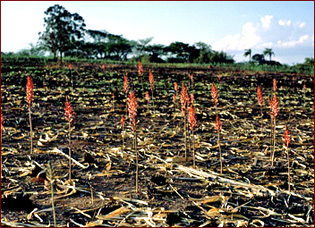 Sacoila lanceolata (habitat) |
LUCIANO: The species of Cyrtopodium, as well the species of Habenaria and those from the subtribe Spiranthinae, occur, mainly in open environments, with strong insolation and are found in 'campos limpos' (clean fields) and 'campos sujos' (dirt fields) vegetation. ON: Is there many endemic species for the region? LUCIANO: If we are talking about DF, the answer is no. If we are talking about the biome Cerrado, the answer is yes. |
|
The
pertinent information about the species is nothing more than the results
of collections. As we have already said, DF is a region very well collected
and, in opposition to the biome Cerrado as a whole. Many species have
already been described for DF, however, additional collections showed
that those species were not exclusively for DF. On the other hand, there
is a region of the Central Plateau which involves DF, Chapada dos Veadeiros
and Pirenópolis, which has many endemic species in common. |
|
ON:
You talked about taxonomical adjustments and migration for another genera,
how do you consider Beadlea e Cyclopogon?
LUCIANO: This is not a group that we have intensively studied. However, in general, we accept Garay's work (A generic revision of the Spiranthinae, de 1980). Very big genera such as Cyclopogon, for example, will be always liable to the division to make taxonomists' work easier. However, all suggestions and alterations are just hypothesis which need to be tested. Concerning Beadlea, between another alterations, Garay used the column's structure (more specifically of the rostellum and the clinandrium) to separate a group of species which belonged to Cyclopogon. In our region there are few species of the studied genera and, for this reason, we hadn't many opportunities to examine alive plants of them. For the species I examined, the characteristics pointed out by Garay were concordant. JOÃO: This is a kind of question that should be analyzed case by case in regarding of the data and available evidences. Considering another case, as happened to Laelia, the modification was clearly necessary, since it was clear that the Brazilian and Mexican species were really very distant and as the name was originally used to Mexican plants, it is not appropriate to use the same name for the Brazilian ones. However, what could be still questionable, because it is subjected to a certain dose of subjectivity and personal choice, it is the solution adopted by different authors who have been working with this group, since many options of transference and adjustment were possible. |
|
ON:
Habenaria is one of the most rich genera of the family and one
of most spread by the continents. Between most of 150 species found in
Brazil, which is the number you found in the researched area?
JOÃO: Only in DF, there are 77 taxa, including 74 species, two varieties and a form. Between them, we just don't know a species, Habenaria ekmaniana, collected by Ezechias Heringer, in 1965, and never found again in this place. When we started our studies in DF, at about 40 species were already known for the region, we added more 30 and, for sure, there are discoveries to be done in this place. As the genus is very well represented, locally, we set to work with the taxonomical study also collecting in another regions. Nowadays, concerning the Brazilian species as a whole, we have material of 120 taxa, approximately, but we think that the total number of species of Habenaria |
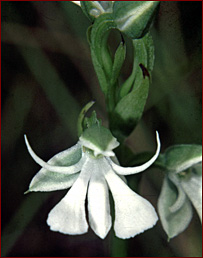 Habenaria leucosantha |
occurring in Brazil should mount to 200. Regarding to the number of species,
Habenaria is the second genus of Orchidaceae in Brazil, just behind
Pleurothallis.
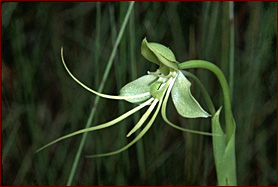 Habenaria gourli |
|
ON:
In a work published in Acta Botanica Brasilica (A Checklist of the Orchidaceae
from the Federal Distrito), you informed that 72 genera and 254 taxa
are recognized only for DF, with more than 73% presenting terrestrial
habit, representing 51% of all orchids registered for the biome Cerrado.
It is amazing the number of Habenaria, 77 as João said
above, Cyrtopodium (17 species) and Cleistes (13 species) mainly, as
you mentioned, if considered that DF represents just 0,3% of the whole
area of Cerrado. Concerning Habenaria, which the species have
a great number of specimens? |
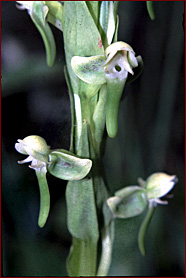 Habenaria obtusa |
| ON:
In which kind of habitat, they occur? JOÃO: The three mentioned species occur mainly in em dry lands and woodland savannas. Habenaria are exclusively terrestrial and occur mainly in field formations, including flood lands, humid and dry fields, but also they can be found in cerrado sensu strictu and, in small quantity, in woody formations. Some species grow literally in the water, some others grow in the completely dry rocky hillsides. One of them succeeds in growing under the earth cumulated between the sheaths of a palm's leaves, many meters above the ground, but none species of the genus, at least between American species, is strictly epiphyte. |
|
ON:
The Central Plateau is specially rich in this genus but it doesn't occur
only in Brazil, which are the another centers of occurrence? |
| Photos: João A. N. Batista |
|